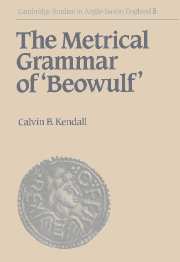Book contents
- Frontmatter
- Contents
- Preface
- List of abbreviations
- List of changes from Klaeber's text
- 1 The Beowulf-poet and his metrical grammar
- 2 The alliterative and metrical principles of Beowulf: Kuhn's ‘laws’ and the transformational rule
- 3 The three kinds of half-lines: extra-metrical alliteration and type A3
- 4 Displacement
- 5 Stressed proclitic adjectives: X-positions and the insertion rule
- 6 Problems with the identification of clause-non-initial half-lines: the proclitic onset
- 7 Half-lines with internal clause divisions: the transformational rule (revised)
- 8 The alliterative requirement of unstressed prefixes and the copulative conjunctions
- 9 The alliterative requirement of prepositions and the proclitic adverbs and instrumentals
- 10 The alliterative requirement of proclitic adjectives and pronouns: the alliterative rule of proclitics
- 11 Displaced and detached proclitics
- 12 The three classes of compounds: the alliterative requirement of class I compounds
- 13 The alliterative behaviour of class II compounds
- 14 The alliterative behaviour of class III compounds and simplexes
- 15 Metrical typology and the metrical grammar
- 16 Conclusions
- Appendix: A typology of the metre of Beowulf in relation to the metrical grammar
- Glossary of technical terms
- Bibliography
- Index of alliteration, scansion and metrical clause structure
- Index of verses specially discussed
15 - Metrical typology and the metrical grammar
Published online by Cambridge University Press: 22 September 2009
- Frontmatter
- Contents
- Preface
- List of abbreviations
- List of changes from Klaeber's text
- 1 The Beowulf-poet and his metrical grammar
- 2 The alliterative and metrical principles of Beowulf: Kuhn's ‘laws’ and the transformational rule
- 3 The three kinds of half-lines: extra-metrical alliteration and type A3
- 4 Displacement
- 5 Stressed proclitic adjectives: X-positions and the insertion rule
- 6 Problems with the identification of clause-non-initial half-lines: the proclitic onset
- 7 Half-lines with internal clause divisions: the transformational rule (revised)
- 8 The alliterative requirement of unstressed prefixes and the copulative conjunctions
- 9 The alliterative requirement of prepositions and the proclitic adverbs and instrumentals
- 10 The alliterative requirement of proclitic adjectives and pronouns: the alliterative rule of proclitics
- 11 Displaced and detached proclitics
- 12 The three classes of compounds: the alliterative requirement of class I compounds
- 13 The alliterative behaviour of class II compounds
- 14 The alliterative behaviour of class III compounds and simplexes
- 15 Metrical typology and the metrical grammar
- 16 Conclusions
- Appendix: A typology of the metre of Beowulf in relation to the metrical grammar
- Glossary of technical terms
- Bibliography
- Index of alliteration, scansion and metrical clause structure
- Index of verses specially discussed
Summary
Students of Old English metrics are well aware of the importance of grammar for understanding the nature of metre. The systematic analyses of Sievers, Pope and Bliss, however much they differ in emphasis and detail from each other, are based on careful investigations of the patterns of stress and syntax revealed by Old English verse. Their work has established beyond a doubt the general validity of the metrical classifications which are usually identified by the Sievers types (Bliss's typology, which is derived from Sievers's, has been gaining in acceptance), even though the significance of the classifications, especially for performance, remains very much an open question. Nevertheless the Sievers typology is limited in its usefulness by its rather too narrow focus on metre, which has tended to mask some of the evidence of the metrical grammar.
The study of the metrical grammar which is the subject of this book puts this evidence in a new light. The level of abstraction represented by the five types is misleading when, for example, it leads to the quite valid generalization that the ‘types may occur in any combination or sequence’. When properly analysed, the metrical types are not completely interchangeable. And I do not refer merely to the well-known fact that double alliteration limits any half-line to the a-verse.
The onset of the half-line determines which of the three basic types it belongs to.
- Type
- Chapter
- Information
- The Metrical Grammar of Beowulf , pp. 200 - 205Publisher: Cambridge University PressPrint publication year: 1991



